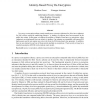TIT
2011
14 years 2 months ago
2011
Abstract. In 1998, Blaze, Bleumer, and Strauss proposed a cryptographic primitive called proxy re-encryption, in which a proxy transforms – without seeing the corresponding plain...
CISC
2008
Springer
14 years 9 months ago
2008
Springer
Proxy re-encryption is a cryptographic primitive developed to delegate the decryption right from one party (the delegator) to another (the delegatee). So far, research efforts hav...
CANS
2008
Springer
14 years 9 months ago
2008
Springer
Proxy re-encryption (PRE), introduced by Blaze, Bleumer and Strauss, allows a semi-trusted proxy to convert a ciphertext originally intended for Alice into an encryption of the sa...
NDSS
2005
IEEE
15 years 22 days ago
2005
IEEE
In 1998, Blaze, Bleumer, and Strauss proposed an application called atomic proxy re-encryption, in which a semi-trusted proxy converts a ciphertext for Alice into a ciphertext for...
PAIRING
2007
Springer
15 years 1 months ago
2007
Springer
A proxy re-encryption system allows the proxy to transform ciphertexts encrypted under Alice’s public key into the different ciphertexts that can be decrypted by Bob’s secret ...
ACNS
2007
Springer
15 years 1 months ago
2007
Springer
In a proxy re-encryption scheme a semi-trusted proxy converts a ciphertext for Alice into a ciphertext for Bob without seeing the underlying plaintext. A number of solutions have ...
ICIC
2009
Springer
15 years 1 months ago
2009
Springer
Recently, proxy re-encryption scheme received much attention. In this paper, we propose a proxy re-encryption used for divert ciphertext from one group to another. The scheme is bi...
CTRSA
2009
Springer
15 years 1 months ago
2009
Springer
Proxy re-encryption (PRE) allows a proxy to convert a ciphertext encrypted under one key into an encryption of the same message under another key. The main idea is to place as lit...
IDTRUST
2009
ACM
15 years 1 months ago
2009
ACM
Mailing lists are a natural technology for supporting messaging in multi-party, cross-domain collaborative tasks. However, whenever sensitive information is exchanged on such list...

